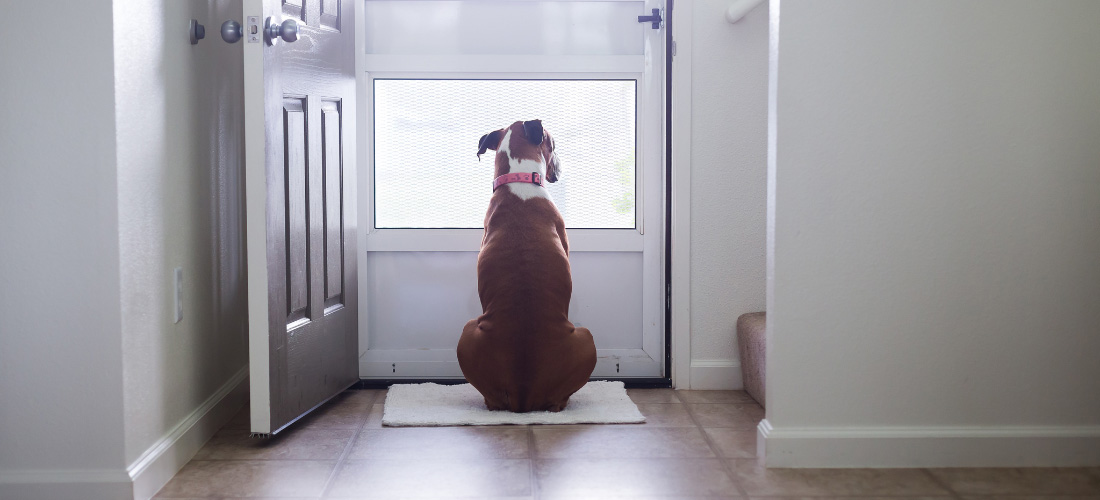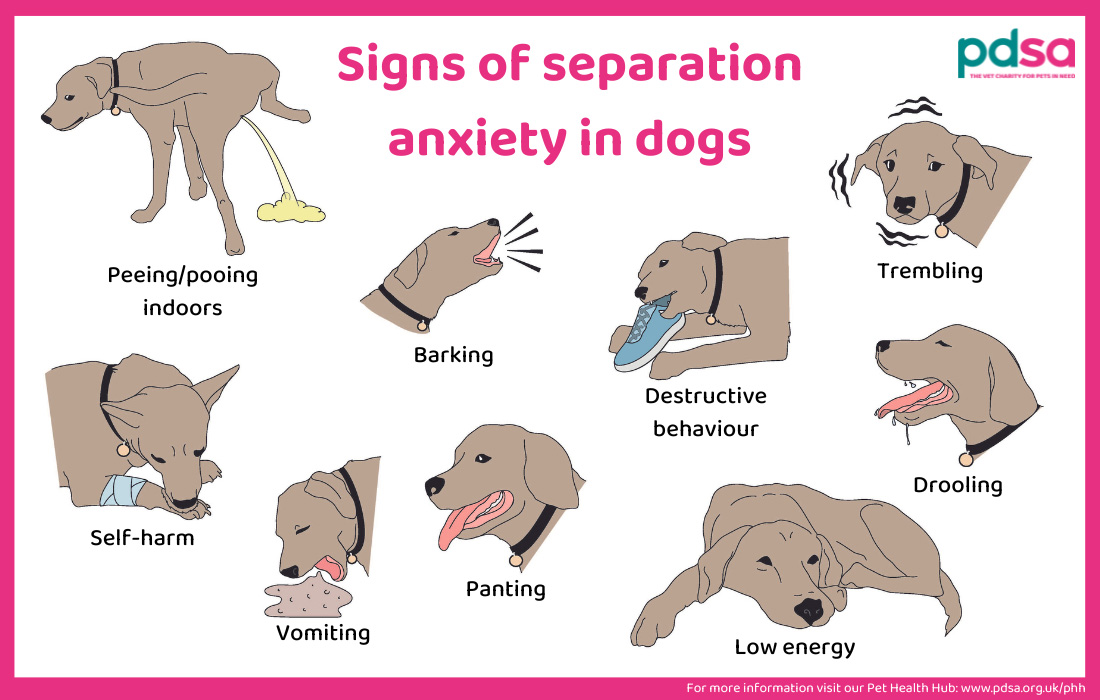Separation anxiety in dogs
Overview
- Separation anxiety is when a dog feels anxious when they’re alone, or away from the human to which they are most bonded.
- These days, vets often use the broader term ‘separation-related problem’ because not all dogs that struggle being alone feel anxious, some feel scared, panicked, frustrated, bored, or even over-excited.
- Separation-related problems are extremely common in dogs, and often have a huge impact on the dog and their owner’s quality of life.
- It’s often possible to improve a separation-related problem with behavioural therapy, training, changes at home, and sometimes medication (if appropriate).

A separation-related problem is when a dog becomes stressed, panicked, anxious, frightened, frustrated, and/or over-excited when they are alone, or away from a particular person. Unfortunately separation related problems are very common in dogs and tend to have a huge impact on their quality of life.
Symptoms
A dog with a separation-related problem is likely to show one or more of the following signs when they are alone or away from a particular person:
- Barking/whining/howling
- Excessive drooling
- Vomiting
- Peeing or pooing in the house
- Panting
- Trembling
- Self-harm (licking, nibbling, or biting parts of their body)
- Destructive behaviour such as chewing, ripping, biting, or digging at items (it’s important to be aware that this behaviour doesn’t always mean the dog is unhappy – they could be having fun, a veterinary behaviourist can help determine which by watching a video of your dog performing the behaviours)
- Low energy and appearing depressed
If you are unsure whether your dog has a separation problem, you may need to consider using a pet monitoring camera. Or ask a neighbour if they’ve noticed anything while you’re out the house. Sadly, for dogs that don’t show obvious symptoms of a separation problem, the issue can easily go unnoticed, especially because they often improve once they are back with their caregiver.

Why does my dog have a separation problem?
There are many different things that can cause a separation-related problem, including:
- Past experiences - if your dog has had a negative experience in the past when they’ve been left, such as being scared or injured, they might think something bad is going to happen every time they are left.
- Lack of independence as a puppy - your dog may struggle being left if they didn’t gradually get used to being left alone when they were young.
- Over-attachment - if your dog is very attached to you or someone else in their household, they may struggle to be left.
- Lack of security - if your dog doesn’t feel secure at home, they are likely to become anxious when they are left. This can also happen if your dog has had a lack of security in the past i.e. spent time in rehoming shelters, kennels, or has moved home several times.
- Inappropriate environment – some dogs need more mental stimulation than others - if your dog has nothing to do when left alone, they may resort to chewing or destroying things.
- Noise phobias - if your dog is afraid of certain noises, they may become anxious when left, especially if they hear the noise they’re afraid of while you are gone.
Treatment
It’s commonly thought that treats, toys and chews will help a dog feel less anxious when they are left alone. However, this will only help in a small number of cases i.e. if the dog is bored or hungry, and even then, the toy will only last a limited amount of time. Most dogs in distress won’t eat or be interested in toys.
The best way to help your dog is to find a professional, such as an ABTC certified behaviourist. Your dog’s treatment is likely to involve a combination of steps, such as:
Assessment:
A certified behaviourist will be able to help you understand why your dog feels the way they do. They will do this by asking you questions, spending time with your dog, and watching them when they are with you and alone (often by using cameras).
Behavioural therapy to change the way your dog feels about being left:
Changing the way your dog feels about being left alone can be done using a technique known as 'desensitisation and counterconditioning'. In simple terms, this means gradually getting your dog used to being alone (desensitisation) and then getting them to think of it as a positive thing (counterconditioning).
Adjustments at home:
This is likely to involve you making some changes such as building your dog a den/safe place and giving them a choice of activities to do when they are alone.
Creating routines:
Giving your dog a routine so they know when you are leaving and what happens when you are out of the house can help build their confidence and reduce their anxiety.
Medication:
Medication is often necessary alongside behavioural therapy, but can usually be stopped once they’ve learnt to cope on their own.
Managing separation related problems takes a lot of time, effort, and commitment from caregivers - most dogs will improve with the right help but this change is likely to take some time.
Prevention
The best way to help prevent separation-related problems is to teach independence at a young age.
When you first get your new dog, you’ll need to teach them that being left alone is normal and not scary. You can do this by gradually increasing the amount of time you leave them alone and rewarding them for it. Be patient and start with simple steps such as:
- Walk a short distance away from your puppy and reward them if they stay calm and settled.
- Leave your puppy alone in a room for a few seconds and reward them if they are calm and quiet.
- Repeat this process and gradually increase the time you are away from them.
- Stay calm and quiet when you leave and come back to teach your puppy that this is normal and there is nothing to be excited or stressed about.
- Give your puppy a safe and comfortable space of their own, such as a crate or den. It can help to put an item of your clothing (that smells like you) in their space, to keep them calm and settled.
- Teach your puppy to use interactive toys, like treat dispensing toys or puzzles, so they’ll have something to keep them happy whilst you are away. Just make sure that the toy is pet-safe and can’t be chewed up or swallowed.
- Use a dog flap leading to a secure garden so that your pet can happily go outside and use the toilet.
- If this isn’t suitable, then you’ll need to make sure that someone can come and let your puppy out regularly for exercise and a toilet break.
- Dogs shouldn’t be left alone for more than 4 hours at a time. Consider a pet sitter or dog walker if you are going out of the house for longer than this.
- Try vet-approved plugin diffuser or a collar that releases natural calming pheromones – but consult your vet before using these.
Published: January 2024
Did you find this page useful?
Tell us more
Please note, our vets and nurses are unable to respond to questions via this form. If you are concerned about your pet’s health, please contact your vet directly.
Thank you for your feedback
Want to hear more about PDSA and get pet care tips from our vet experts?
Sign up to our e-newsletter
Written by vets and vet nurses. This advice is for UK pets only. Illustrations by Samantha Elmhurst.

